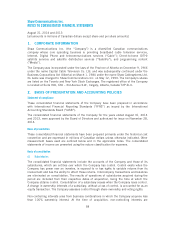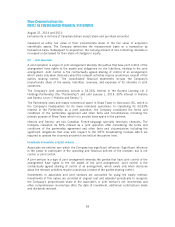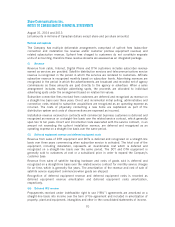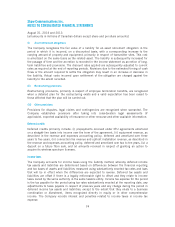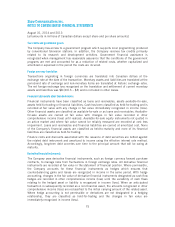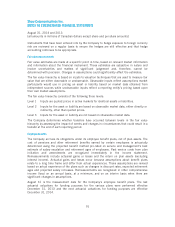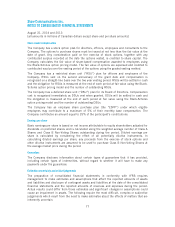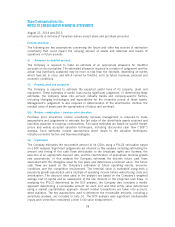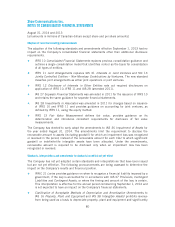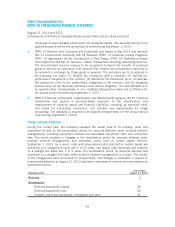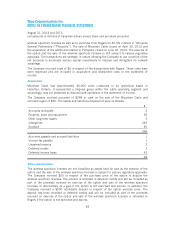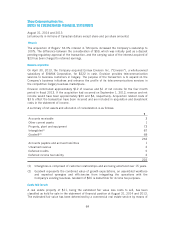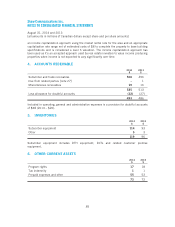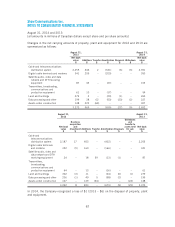Shaw 2014 Annual Report Download - page 82
Download and view the complete annual report
Please find page 82 of the 2014 Shaw annual report below. You can navigate through the pages in the report by either clicking on the pages listed below, or by using the keyword search tool below to find specific information within the annual report.Shaw Communications Inc.
NOTES TO CONSOLIDATED FINANCIAL STATEMENTS
August 31, 2014 and 2013
[all amounts in millions of Canadian dollars except share and per share amounts]
Estimation uncertainty
The following are key assumptions concerning the future and other key sources of estimation
uncertainty that could impact the carrying amount of assets and liabilities and results of
operations in future periods:
(i) Allowance for doubtful accounts
The Company is required to make an estimate of an appropriate allowance for doubtful
accounts on its receivables. The estimated allowance required is a matter of judgement and the
actual loss eventually sustained may be more or less than the estimate, depending on events
which have yet to occur and which cannot be foretold, such as future business, personal and
economic conditions.
(ii) Property, plant and equipment
The Company is required to estimate the expected useful lives of its property, plant and
equipment. These estimates of useful lives involve significant judgement. In determining these
estimates, the Company takes into account industry trends and company-specific factors,
including changing technologies and expectations for the in-service period of these assets.
Management’s judgement is also required in determination of the amortization method, the
residual value of assets and the capitalization of labour and overhead.
(iii) Business combinations – purchase price allocation
Purchase price allocations involve uncertainty because management is required to make
assumptions and judgements to estimate the fair value of the identifiable assets acquired and
liabilities assumed in business combinations. Fair value estimates are based on quoted market
prices and widely accepted valuation techniques, including discounted cash flow (“DCF”)
analysis. Such estimates include assumptions about inputs to the valuation techniques,
industry economic factors and business strategies.
(iv) Impairment
The Company estimates the recoverable amount of its CGUs using a FVLCS calculation based
on a DCF analysis. Significant judgements are inherent in this analysis including estimating the
amount and timing of the cash flows attributable to the broadcast rights and licenses, the
selection of an appropriate discount rate, and the identification of appropriate terminal growth
rate assumptions. In this analysis the Company estimates the discrete future cash flows
associated with the intangible asset for five years and determines a terminal value. The future
cash flows are based on the Company’s estimates of future operating results, economic
conditions and the competitive environment. The terminal value is estimated using both a
perpetuity growth assumption and a multiple of operating income before restructuring costs and
amortization. The discount rates used in the analysis are based on the Company’s weighted
average cost of capital and an assessment of the risk inherent in the projected cash flows. In
analyzing the FVLCS determined by the DCF analysis, the Company also considers a market
approach determining a recoverable amount for each unit and total entity value determined
using a market capitalization approach. Recent market transactions are taken into account,
when available. The key assumptions used to determine the recoverable amounts, including a
sensitivity analysis, are included in note 10. The DCF analysis uses significant unobservable
inputs and is therefore considered a level 3 fair value measurement.
78


